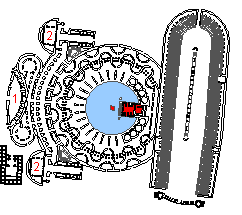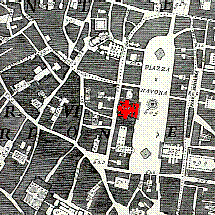Persecution of the Christians under emperor Decius.
Earliest date associated with the martyrdom of Saint Agnes.
| |
1999.03.31
contributing sperm for egg fertilization
This contribution was going to be a short piece written as a male "donation" to The Architect: Reconstructing Her Practice. I was going to feature Constantina, the daughter of Constantine (the Great) as the first architect of sacred Christian sites. I don't know if I can do this now because I may have gotten my facts messed up with regard to Constantina being instrumental in building S. Agnes (outside the Walls). I read somewhere that it was her project, and because of that I've surmised this whole scenario where it was she, and not her Emperor father, who was behind the initial Christian building within Rome.
I was set to tell the Constantina story and the St. Agnes (martyrdom) story, and I was going to play up the whole reversal (inversion) motif. I particularly liked entertaining the notion that Constantina constructed her own practice. It was all going to make a tremendous story, but right now I don't even know where I read about Constantina's connection with the St. Agnes Church.
I may still have something here, but I doubt it will be as big a flash as I originally thought.
I was even going to dedicate the text to Francesca Hughes (editor of The Architect) and all the woman (architect) authors within The Architect, and in so doing clear up the seemingly universal Immaculate Conception misunderstanding once and for all.
1999.04.21
21 April 1999 (Rome's birthday)
The path that ultimately lead me to Helena began with my learning about a deliberate connection between Piranesi's Ichnographiam Campi Martii and Saint Agnes of Rome. According to ancient tradition, the first "structure" within the Campus Martius was an altar erected by Romulus in honor of his father Mars. Piranesi situates the Ara Martis within the generally accepted location of the original altar, that is, within the area between the present day Piazza Navona and the Tiber to the west. In Piranesi's plan, the altar of Mars is within a circular pool in front of a Temple of Mars and is furthermore surrounded by an extensively curvilinear porticus. Additionally, the Domus Alexandri Severus (1) flanked by two Sessorium (2) is to the west.
 
Investigating the meaning of Piranesi's Ara Martis layout, I looked to Nolli's 1748 Plan of Rome for a possible connection. I chose this approach because I had already learned that Piranesi indeed sometimes cleverly disguised links between his Ichnographiam and Nolli's plan. The only potential tie between the two maps at the Ara Martis juncture is the coinciding position of the Templum Martis and the baroque church of St. Agnes on the Piazza Navona. At this point it became necessary for me to investigate the story of Saint Agnes.
Saint Agnes died in Rome circa 249 as a thirteen year old virgin and martyr. "Her riches and beauty excited the young noblemen of the first families of Rome to contend as rivals for her hand. Agnes answered them all that she had consecrated her virginity to a heavenly husband, who could not be beheld by mortal eyes. Her suitors, finding her resolution unshakable, accused her to the governor as a Christian, not doubting that threats and torments would prove more effective with one of her tender years on whom allurements could make no impression."1 As a form of torture, Agnes was sent to a brothel where her vow of virginity would be threatened and almost certainly eradicated. According to the legend, however, an angel protected Agnes while she was in the brothel, and subsequently Agnes was put to death. The traditional location of the brothel of Agnes' torture is the site of St. Agnes on the Piazza Navona. Moreover, the subsequent execution of Agnes sent shockwaves throughout both pagan and Christian Rome because the worst possible thing any Roman could do was to kill a virgin. Suddenly, and ironically, the Roman persecution of Christians took on the guise of a pagan moral dilemma.
The martyrdom of Agnes signifies a pivotal point of pagan-Christian inversion, and this inversion is precisely what Piranesi delineates within the complex of the Ara Martis. First, the co-positioning of the Templum Martis and the church of St. Agnes represents the origin of Rome itself when Mars raped the Vestal Virgin Rhea, who subsequently became mother to Romulus and Remus. Second, the emperor Alexander Severus is known for having been very interested and sympathetic towards Christianity, to the point where he seriously considered proclaiming Jesus as one of the official Roman gods as well as carving the (inverting) words "do unto others as you would have them do unto you" over the door of his house. Third, Sessorium is a direct reference to the Palatium Sessorianum, the imperial estate that became Helena's residence in Rome after 312, and soon thereafter the church of Santa Croce in Gerusalemme. It seems quite evident that Piranesi was well aware of early Christian history, including its architectural history.
Personally, I wonder whether Piranesi recognized Helena as an architect as well.
1 Herbert Thurston, S.J. and Donald Attwater, editors, "St Agnes" in Butler's Lives of the Saints (New York: P.J. Kenedy & Sons, 1956), v. 1, pp. 133-4.
|